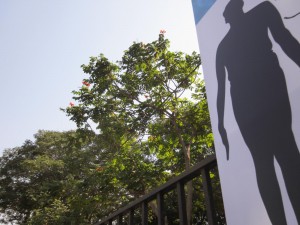16th December 2014
“We are always looking outward, listening to our teachers who come with their own problems and limitations and we ignore the most supreme teacher within ourselves. The only way to evolve, to progress, to truly practice, is to listen to our inner teacher.” Prashantji Iyengar”
On Monday, Tuesday, Thursday and Saturday we take the early morning class with Prashant 7 – 9am.
Prashant has a wonderful way of teaching us to take the journey of Yog through imagery. Today we explored the relationship between the breath and the body.
He described how that relationship could be discerned in 3 ways
Known: This could be the knowledge we already have about the breath e.g. the physiology, the mechanics of how the breath works.
Knower: This could be the way in which we explore the body with breath, as though one was using an instrument or tool to find places we have never explored before
Knowing: This could be the subjective experience we have of the way in which the breath affects the body so we might notice the breath moving the skin around the rib cage horizontally
Then each of the above 3 ways could be applied to
Body – explored as known, knower, and knowing
Mind – explored as known knower and knowing
Breath – explored as known, knower and knowing
Making 9 different ways in which we might explore the asana!
So when we approach a simple twist like Bharavajasana 1, we were encouraged to explore the inhalation in any one of the above ways.
I found that it felt quite different when I actively set out to explore the body with the breath as something more instrumental, the knower actively seeking and searching for something. For example I set out to consciously focus on taking the breath into the upper chest, and find spaces there, this is an area I find difficult to reach, and with this kind of focus it did feel as though I was an archeologist excavating a new area.
We repeated the same asana 3 or more times, Prashant says that in his classes he asks us to repeat the same pose again and again for an important reason. When we first do the asana we approach it as a doer with the mind, we set up our equipment and focus on getting it right, but it is only once we have repeated the poses several times do we start to experience something different. This is because at that point we start to explore the asana in other ways. Certainly I felt this.
We rotate in small groups, I use the ropes first holding in a purvottanasana position and then swinging forwards and backwards to open the chest. Once I had done these movements, I felt I had better access to the upper chest and returned to Bharavajasana again, I tried shifted my focus towards receiving the breath, being less instrumental now and with the affects of the rope practice, I noticed how my approach to the asana could change and I felt the movement of the skin horizontally around the sides of my trunk, and vertically down from the top of the clavicle skin to the inner elbow.
The difference shift in focus he describes as though we were using the internet, ‘net culture’. We start the class before the invocation setting up this net culture, ready to experience, explore and focus our attention in multifaceted ways (the 9 ways). The experience the asana changes when applying different perspectives to exploring it, we make paradigm shifts.
It is clear that we get set in ways of doing things, and our approach must be like education, not for a final result but for the process itself. We have lost our way in the west with Yoga (or Yogaah!). This is because we have become focused on the benefits, the results, the outputs and not on the journey itself. This he illuminated today via the image of a boat and oars. When our ancestors made a boat they used the oars for navigation, for traveling and for movement down the river. Now we use the oars on a rowing machine purely for the function of exercise, we seem to have lots connection with the primary function of the oars.

